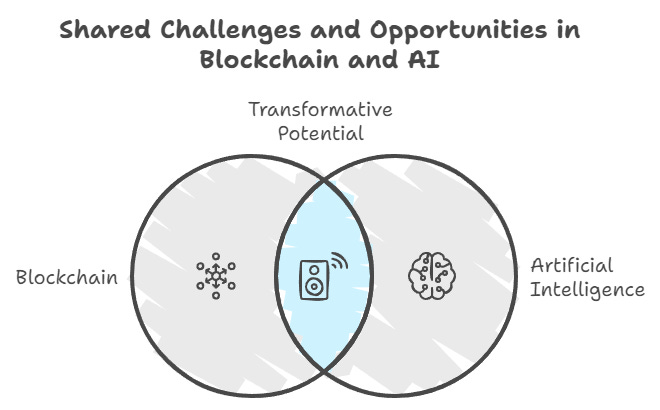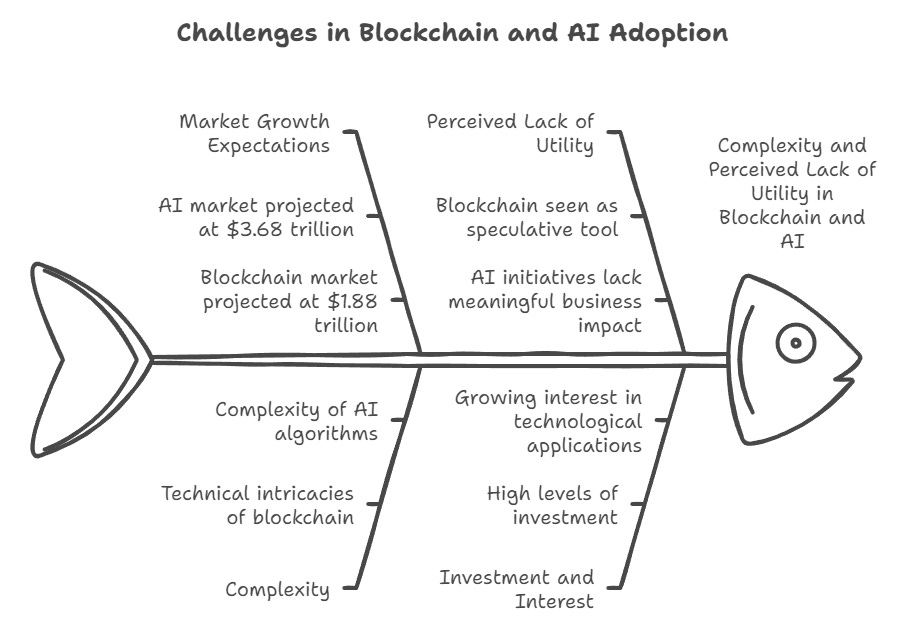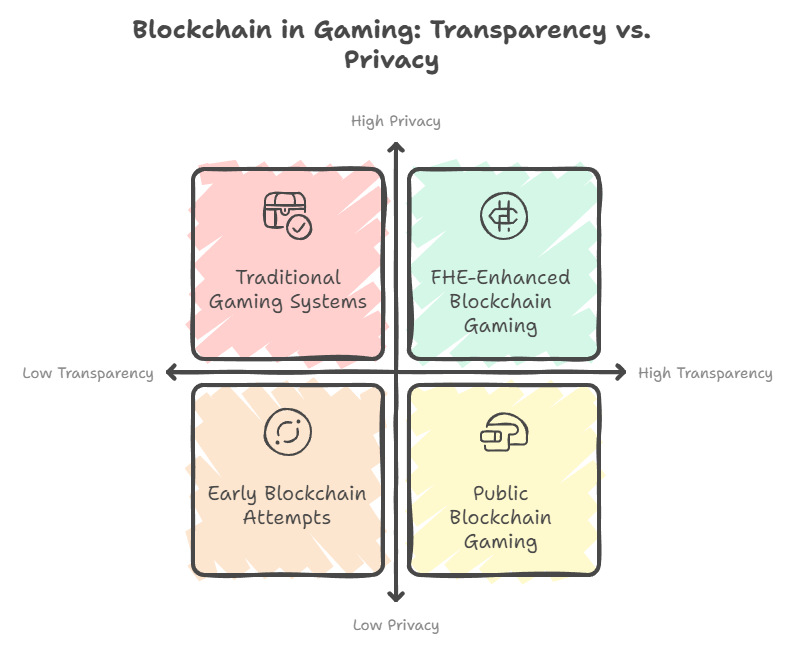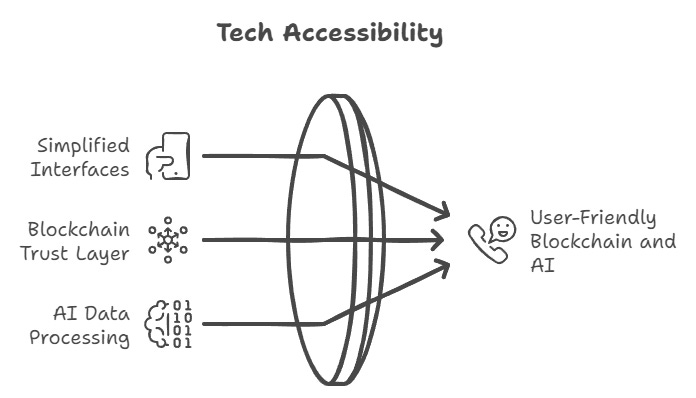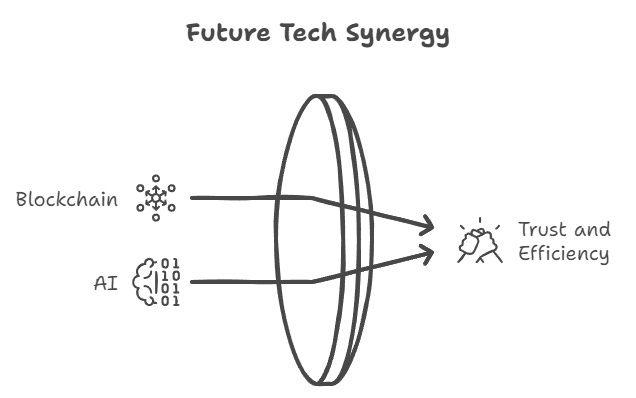Blockchain's Potential, AI's Rise, and Making Tech Truly Accessible
AI and Blockchain's Double-Edged Impact: Complexities, Opportunities, and New Frontiers for Digital Trust
Blockchain technology and Artificial Intelligence (AI) are shaping the future of technological innovation. Both fields are experiencing unprecedented growth, but there are crucial challenges that must be addressed for their transformative potential to be realized. Let’s explore the state of these technologies, their barriers, and the opportunities we have to push them into the mainstream.
1. The Growing Markets of Blockchain and AI
Blockchain and AI are more than buzzwords, they are becoming the pillars of the next era of digital transformation.
Market Growth: The AI market is expected to reach $3.68 trillion by 2034 and continue expanding rapidly. Similarly, the global blockchain market, is projected to grow substantially being valued at $1.88 trillion by 2034, by the end of this decade. These figures signal immense interest and investment in these technologies, but with that comes expectations and challenges.
The Challenge of Complexity: Despite the optimism, blockchain and AI still face issues around complexity and perceived lack of utility. Many perceive blockchain as synonymous with cryptocurrency: a tool for speculation rather than an infrastructure for genuine solutions beyond finance. Meanwhile, AI adoption is hindered by skepticism over its actual business impact, as many initiatives fail to demonstrate meaningful value beyond experimentation.
💡 Key Insight: For both blockchain and AI, the biggest leap forward may not come from technological advancement itself but from making these technologies more intuitive and accessible. This is the only way to ensure that they do not remain exclusive to experts and enthusiasts.
2. Blockchain and AI: The Need for Practical Use Cases
To genuinely capitalize on the potential of blockchain and AI, the focus must be on building practical, everyday use cases that create tangible value.
Beyond Cryptocurrency Speculation: Blockchain has the capacity to offer much more than cryptocurrencies. Its inherent properties: decentralization, transparency, and immutability, can address trust issues in various industries, from supply chain management to healthcare. However, the complexity of the technology has limited its adoption, and real progress will require us to break these barriers down, making the technology understandable and useful even to non-experts.
AI’s Business Impact: For AI, the challenge often lies in operationalizing the technology. Companies are excited about AI’s potential, but initiatives frequently fall short of meaningful outcomes due to a lack of integration into day-to-day processes. AI needs to be embedded in ways that streamline workflows, improve decision-making, and create efficiencies that people can see and feel.
💡 Key Insight: Practicality is the key to mainstream adoption. We need to find ways to turn blockchain and AI into solutions that make everyday lives easier, whether it’s securing data, reducing costs, or providing trust in processes that historically lacked transparency.
3. Blockchain Gaming as a Case Study for Trust and Transparency
One sector where blockchain can play a massive role is gaming, particularly online gaming. For years, online poker and other games have faced issues of trust and fairness where players want to know that the game isn’t rigged, that no one is cheating, and that the systems are transparent.
The Promise of Blockchain: Blockchain technology holds promise for addressing these issues because it provides a decentralized and verifiable record of actions within the game. However, early attempts at integrating blockchain into gaming fell short, mainly because they failed to consider the privacy implications of complete transparency. For instance, making game actions publicly visible on a blockchain undermined the element of secrecy essential for games like poker.
The Role of Advanced Cryptography: This is where cryptographic techniques such as Fully Homomorphic Encryption (FHE) can make a real difference. FHE allows for computations on encrypted data, meaning that gaming platforms could perform all the necessary game logic like shuffling and dealing cards without exposing the actual card values to anyone. Players get the assurance that the game is fair, without compromising the confidentiality that makes these games enjoyable.
💡 Key Insight: Combining blockchain with advanced cryptography is a promising approach to building secure, transparent systems that still maintain privacy critical for applications beyond just gaming.
4. The Broader Vision: Usability and Accessibility
For blockchain and AI to succeed on a broader scale, they must become user-friendly and relevant to the average person’s life.
Improving User Experience: Today, a significant obstacle is the complexity of user interfaces. Blockchain addresses, for example, are still far from being intuitive. They are long, confusing strings that are prone to error. Solutions like subdomains on the blockchain can make these addresses more accessible, similar to how email addresses simplified early internet communications. Making blockchain interactions simple is vital for mass adoption.
Bringing Blockchain and AI Together: There is also a unique opportunity to integrate blockchain and AI in ways that amplify their individual strengths. Blockchain can provide a trust layer, while AI can handle the complex tasks of data processing and analysis. For instance, document processing, identity verification, and supply chain tracking can all benefit from blockchain’s transparency combined with AI’s efficiency in handling large datasets.
💡 Key Insight: The ultimate goal must be to make the benefits of blockchain and AI tangible to people who aren’t necessarily tech-savvy. If we can simplify the user experience, these technologies will move beyond niche applications to become mainstream tools that everyone can leverage.
5. The Path Forward: Blending Trust and Efficiency
The future of blockchain and AI lies in leveraging their complementary strengths to build trust and efficiency into the fabric of our digital infrastructure.
Blockchain as the Trust Layer: Blockchain’s ability to provide a decentralized, transparent ledger makes it ideal for verifying information. Whether it’s tracking the origin of goods in a supply chain or ensuring the fairness of a digital game, blockchain can serve as the foundational layer that provides verifiable truth.
AI as the Processing Power: AI, meanwhile, is the ideal tool for handling complex decision-making and data analysis at scale. Imagine processes like mortgage approvals or medical data management, where AI can rapidly analyze information while blockchain ensures the integrity of the data.
💡 Key Insight: By positioning blockchain as the layer of trust and AI as the tool of efficiency, we can build systems that are not only more powerful but also fundamentally fairer and more transparent.
Key Takeaways:
Growth Potential: Both blockchain and AI are poised for significant growth, but their future success depends on simplifying their adoption and proving real value to the average person.
Practical Use Cases Matter: The key to mainstream adoption lies in everyday use cases that demonstrate practical, tangible benefits.
Combining Blockchain and AI: Leveraging blockchain for trust and AI for data processing can create systems that are both transparent and efficient, opening up new possibilities across sectors.
In Closing:
The evolution of blockchain and AI represents one of the most significant technological opportunities of our time. But to realize this potential, we must focus on making these technologies practical, accessible, and inclusive. By simplifying the complexity and building solutions that are truly useful to everyone, we can ensure that blockchain and AI become tools that empower individuals across the globe.
Disclaimer: The information provided by Insight Labs is for educational purposes only. It is not intended to be, and should not be taken as, legal, tax, investment, financial, or any other form of professional advice.




